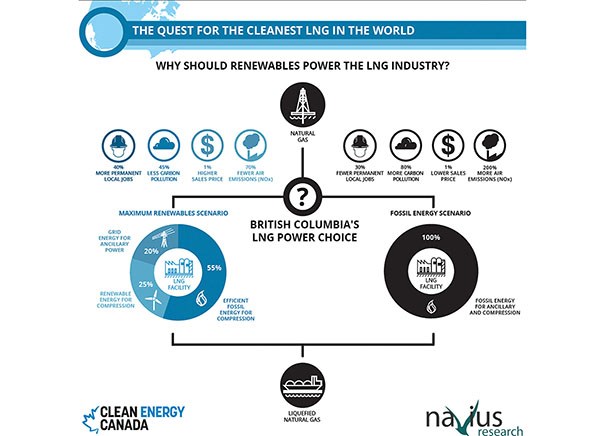This is the second in an ongoing series of Q&A columns provided by The Squamish Chief where experts are given the opportunity to answer questions asked by the community regarding liquified natural gas and related issues in light of the proposed Woodfibre LNG plant. Email your questions or ideas to [email protected].
What is the difference in greenhouse emissions between an electric-run LNG export facility versus a gas-powered facility?
Last year, we looked into the LNG plants proposed for Prince Rupert and Kitimat, and found that if companies powered those plants with electricity, they would reduce their carbon pollution by 45 per cent relative to the standard approach of burning a portion of the incoming natural gas supply. Though our study didn’t specifically look at the Woodfibre LNG proposal, we expect the carbon reductions there will be even larger because the company intends to use grid electricity in its proposed plant.
Grid power here in British Columbia is exceptionally clean – it’s 93 per cent renewable, straight out of the wall. Our preliminary estimates suggest Woodfibre will reduce its carbon pollution by 80 to 85 per cent at its proposed facility, relative to burning natural gas.
What is the cause of greenhouse gas emissions if the process is done with electric drives?
Before LNG plants can chill and liquefy natural gas for shipment, they need to “clean it up.” This involves scrubbing out the carbon dioxide that is locked up in the natural gas; typically, it is vented to the atmosphere. Sometimes, LNG plants will also flare – burn off – natural gas during operations, which also creates greenhouse gas emissions. Finally, plants leak greenhouse gases from their pipes and valves. The 80 to 85 per cent reduction noted above does not include these leaks and this venting.
What countries or facilities should we look to as good examples of LNG facilities and why?
From a carbon-pollution perspective, the cleanest LNG in the world is produced by a pair of plants, one operating in Norway, and another now under construction in Australia. Our analysis found that, from a climate disruption perspective, LNG produced on the North Coast will likely be three times more polluting than that which these two facilities produce.
This is factoring in the source of the natural gas, how it’s produced and processed, and how it’s delivered to the facility. By relying on grid electricity, the proposed Woodfibre LNG plant will only be twice as polluting as the Norway and Australian LNG plants.
It’s still more polluting than these world leaders because of the carbon pollution from natural gas production, processing and transporting in British Columbia.
What do you think residents should consider when exploring the Woodfibre proposal?
Last year we looked into what it would take for a company to deliver on the province’s promise to produce the “cleanest LNG in the world.” We found it takes three commitments: First, the company would need to run its chilling equipment and natural gas production operations on clean and renewable electricity instead of natural gas. Second, it would need to specify the cleanest natural gas available – that is, gas that either contains very little carbon dioxide, or that’s had its carbon dioxide “stripped out” and stored underground.
Third, the company would need to ensure that no carbon pollution leaks out of the pipes and the processing plants between the wells in Northeastern B.C. and its plant on the coast.
So far, the Woodfibre LNG project only partially checks one of those three boxes – it only electrifies the production at the facility, and not all the way up the chain back to the wellhead. The company has said it will use electricity from renewable sources to power its LNG facility. That’s a great start, and an example for others to follow. But to be world leading, the company needs to address these other issues as well. See more on cleanestLNG.ca
Engineer Jeremy Moorhouse focuses on British Columbia’s proposed LNG sector, sustainable transportation, and renewable energy. Recently he co-authored Lock In Jobs, Not Pollution, and The Cleanest LNG in the World? a pair of reports on British Columbia’s proposed LNG industry.



